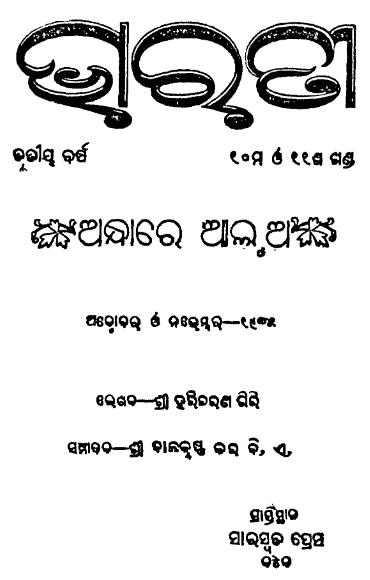In the rich tapestry of Odia literature, Andhare Alua, published in 1935 by the talented author Hari Charana Giri, stands out as a compelling narrative that intertwines themes of darkness, struggle, and the indomitable human spirit. This novel, whose title translates to Light in Darkness, resonates with readers not only for its engaging storytelling but also for its profound exploration of societal issues and personal redemption.
Set against the backdrop of early 20th-century Odisha, Andhare Alua tells the story of its protagonists navigating a world fraught with challenges. Giri deftly portrays the complexities of human emotions and relationships, bringing to life characters that are both relatable and deeply flawed. The novel effectively captures the essence of its time, reflecting the socio-political landscape and the struggles faced by individuals within it.
At its core, Andhare Alua is a tale of resilience in the face of adversity. The characters are often confronted by societal norms, economic hardship, and personal dilemmas, yet they persist in their quests for hope and redemption. Giri’s intricate character development allows readers to connect with their journeys, evoking empathy and understanding. The protagonist’s experiences mirror the broader struggles of the Odia community during a time of transformation, making the narrative both personal and universal.
One of the most striking elements of Andhare Alua is Giri’s use of symbolism and metaphor. The titular “light” serves as a powerful symbol throughout the novel, representing hope, knowledge, and the quest for a better future. In contrast, the “darkness” encapsulates the hardships and challenges that threaten to engulf the characters. This interplay between light and darkness not only adds depth to the narrative but also invites readers to reflect on their interpretations of hope and despair.
Giri’s prose is imbued with lyrical quality, showcasing his mastery of the Odia language. His vivid descriptions bring the settings and characters to life, immersing readers in the sights, sounds, and emotions of the story. The rich cultural context woven into the narrative further enhances its appeal, as readers are introduced to the traditions, values, and complexities of Odia society.
In addition to its artistic merit, Andhare Alua serves as a critical commentary on social issues, including caste dynamics, gender roles, and economic struggles. Giri does not shy away from addressing the injustices prevalent in society, using his characters as vehicles to challenge the status quo. Through their journeys, the novel advocates for change and encourages readers to reflect on their own beliefs and values.
As a work of fiction, Andhare Alua transcends its time, remaining relevant in contemporary discussions around resilience and social justice. The struggles faced by the characters resonate with modern readers, urging us to consider the enduring nature of human experience. The themes of hope against despair, personal growth, and the quest for identity continue to inspire readers to reflect on their journeys and the light they seek in their own lives.
Books Info
| Books name | Andhare Alua / ଅନ୍ଧାରେ ଆଲୁଅ |
| Author | Hari Charana Giri |
| No Of pages | 156 |
| Publisher | Sri Balakrushna Kara |
| Publication | 1935 |
| Printed At | Saraswata Press |
| Distributor | NA |

